#but yasu and tohya...
Explore tagged Tumblr posts
Text
tohyas opponent isnt yasu btw. its battler
#Shitpost#Tohya interacts with the forgeries and the fandom of it all but#really its about him and battler.#this is why people who think ikuko is yasu are sooo wrong though lol
8 notes
·
View notes
Text
kinzo/bice and tohya/ikuko are foils, as filtered through yasu's eyes
starting this off with an assertion that yasu's ideal relationship is kinzo/bice.
she identifies with kinzo: how he went through the motions to do what was expected of him, how he didn't fight against his fate. kinzo was waiting to die but too cowardly to do it himself. he was empty inside and disconnected from his world. then he meets bice, the one person who connected with him, not because of his status, but based on shared interests and camaraderie. kinzo/bice create a universe of two, figuratively and literally. they save each other, run away together, and literally spend the rest of bice's life hidden away and secluded together with just the two of them, happy with their escape from the cruel outside world and its obligations (kinzo)/dangers (bice). kinzo remembers it as the happiest time of his life. and so yasu, who's a kinzo-kin, wants that for herself, and it helps shape her idea of the ideal relationship: a universe of two.
now, onto tohya/ikuko! if yasu's narrative predecessor (kinzo) got the fairytale relationship she dreamed of and aspired to make come true, then her narrative successor (tohya) gets her dream passed down by pure chance...but is it really as idealized as she dreamed of?
because yeah, tohya/ikuko bond over sharing the same interests and can talk as friends! and yeah, they're secluded. no one even knows tohya exists, for the matter. they're free from any obligation to the outside world and don't have to interact with any sort of cruel society. tohya and ikuko only interact with the outside world on their own terms, through the anonymity of the internet, and later as famous authors who can use their wealth to obscure themselves through pen names, agents, etc. they really have created their own single universe. they even choose to share a single identity instead of "splitting" their identities like yasu did.
but. are tohya and ikuko really happy like this? tohya can't just let go of who he was before he met ikuko, no matter how much he wants to. he's not like bice, who was "happy" (we don't even know that for sure, considering that kinzo is an unreliable narrator) going from a wealthy, privileged, worldly life, experiencing severe trauma, then becoming a hermit with a close friend. tohya even has a whole new name but it doesn't change that the trauma follows him. tohya experiences so much guilt for trying to let go of his past, for not reaching out to ange, for trying to protect his new sense of identity as the person who's a mystery novel writing hermit. in short, this isn't some idyllic life for him. and even ikuko, who genuinely likes being a recluse and brought tohya into that life, realizes this isolation isn't it, and maybe they have to break this little bubble of theirs (she does not go about it in the best way: i talk about it a bit here.)
in conclusion, what i'm saying for tohya/ikuko is that the isolated "universe of two" did not cut it. they both suffered, because you can't just cut all ties to the outside world and expect things to be all hunky-dory and you'll live happily ever after, free from sadness and pain.
what brings tohya salvation is reaching out to yukari at the end, breaking his own shell to communicate honestly with someone from his outside world. even if he's not guaranteed a perfect, accepting response, even if she gets justifiably angry, even if he's scared - like tohya says, he should have done it a long time ago
anyway, i'm going to end off with this screencap. because battler Got It. not a secluded universe of two, untethered to the rest of the world. but a relationship where you will experience the world together. that's living.
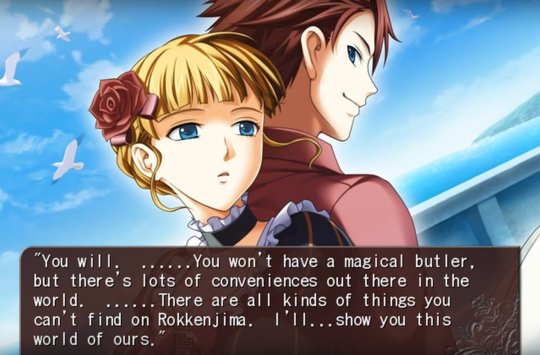
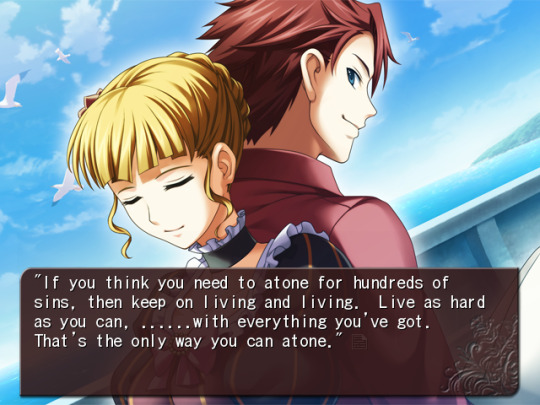
4 notes
·
View notes
Text
In re-reading Umineko for our latest ramble I've come to really appreciate the care and love Ryukishi put into the topic of complicated grief.
Consider this an end-coda of the two big essays (other one here) and a way of tying their themes together.
This is a short one, I promise, but I'll put it under readmore for spoilers sake.
Basically I want to talk about imagination, processing and the stories we tell ourselves to cope.
When we look at the game boards of each chapter as being authored works in universe we get a lot of information about the authors of the works.
Chapters 1 and 2 are Beatrice/Yasu, penning these elaborate revenge fantasies that haven't happened yet as both a twisted love letter to Battler, who stoked her passion for murder mysteries, and a way of coping with her pain and loss. No matter how boisterous and sinister Beatrice imagines herself to be, we do see in Chapter 7 that when she is given the family gold she is quite shy and meek and reserved and remains that way when the family discover her about to enact her revenge plot.
Beatrice as an alter/part of Sayu's dissociative system is a coping mechanism but in the end she was not capable of those acts in reality. She was able to take her scheming further because of the power she had from the gold and control over the island and its servants but when faced with the act of killing she was just a traumatized kid, unable to commit cruelty. She was as capable of murder as Maria's evil witch persona would be.
The writing was just a fantasy. A projection of her desire to retaliate.
It's also kind of brilliant as only she and Genji know that Shannon/Kanon are treated as two separate individuals by everyone on the island and have 2 separate master keys to compensate. An element of the mystery that could only be known by the mastermind.
Chapters 3-6 are written by an amnesiac Battler. The "forgeries" only began after the messages containing the first two chapters had been discovered and the news started speaking about the Rokkenjima tragedy. This likely triggers "Tohya", the name Battler had taken on, and causes the traumatic events of the island to replay in his head over and over. Every attempt to write it was an attempt to make sense of the scattered remnants hidden behind his own dissociative barriers.
He kept scratching at the itches and trying to make sense of it in a way that was, frankly, exploitative. Especially when he wrote about an unrelated person who died in the typhoon the game takes place in and placed her on the island as The Worst Girl Imaginable.
Sometimes "Umineko is about how shitty true crime as a genre is" can be the correct take.
But in this case he, like Ange, is trying to make sense of the past and turn the events over and over again. We wrote about this concept extensively in our (Dawn's) Ange essay.
The point is, where Beatrice was writing fantasies of the future to cope, Battler-Tohya (via Ikuko) was writing unclear recollections to unearth the traumatic memories that he couldn't quite reach. Inconsistencies like this are typical in recovering traumatic memories.
We experience it in our own life, when we date a memory by the sporting event that was happening about that time but the inciting incident of the memories was tied in the birth of someone who is older than that. When one tries to turn over facts, emotions and painful memories decades in the future it all gets mixed up and doesn't quite match reality. The Ange post has more to say on that.
Eva's journal may well have been written by Eva to hurt Ange. We do not know how much of it is true but when Kyrie monologues about how she intends to abandon her daughter and never loved her as anything more than a solvent to keep her marriage together, you can feel Eva's pen on the page, taunting the child who survived instead of her George.
Which brings us the final chapter and the theme of the game and why I wanted to write this little end-cap.
From our other essay:
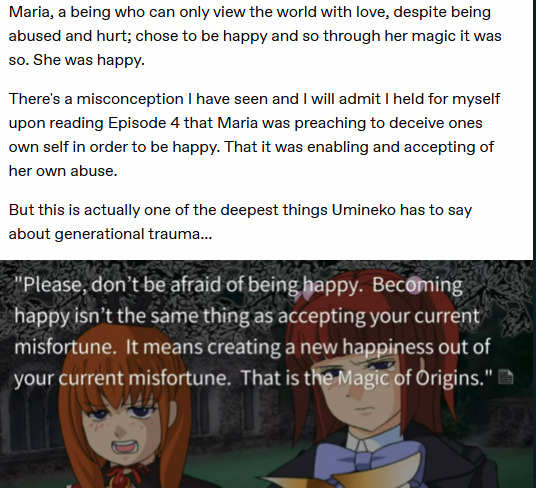
Chapter 8 represents the idea of writing your own past with love and with kindness.
If Beatrice's mysteries in Chapter 1-2 are a wounded person enacting a revenge fantasy about the future, why not write a healing fantasy about the past?
Turning over the events over and over will not change the present and can serve to retraumatize a person by allowing the events of the past to intrude on the present.
The start of Chapter 8 even describes the 1998 Ange as such:
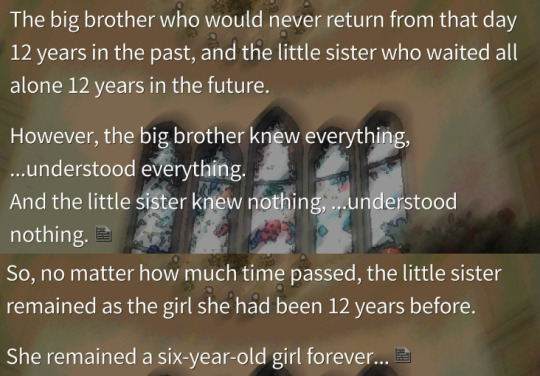
Stuck in trauma time, Ange is unable to grow beyond the tragedy of her entire family dying at once. Battler has all the answers and so he writes a version of the story that is pointedly impossible.
The previous chapter featuring Beatrice II's funeral was based on a "miracle fragment" where Lion had not been raised as Shannon. This was revealed to be the fantasies of Yasu after discovering their identity as Lion. An impossible version of the world that was a "what-if" fantasy.
Chapter 8 tells a similar story but it's not a "what if" in the sense that it would require a different world to function. It is the idea baked into Ange's power as the Witch of Resurrections. With imagination and with love it is possible to simply keep lost loved ones alive by writing about them. To process pain by writing a kinder reality because it is not changing the world to believe the best in people, it is simply choosing, as Maria put it, to not accept current misfortune and to choose to live in happiness.
Umineko says we have the choice to paint our outlook on the world.
Hence why Ange abandons her fortune and goes on to write stories about Sakotarou, keeping Maria and her imagination alive and delighting children.
All the way back when we first read Umineko we said that it was Anime House of Leaves.
Turns out both books have the same outcome from different angles.
“Maturity, one discovers, has everything to do with the acceptance of ‘not knowing.”
And acceptance is the only road to healing. We have to close the catbox.
Fantasy and imagination can be an escape, but they can also be a prison that locks a person in their worst experiences. If you truly can't let go. Maybe you can spin the chess board and write yourself a happy ending.
#camden posting#umineko#umineko spoilers#spoilers#media myself and I#(Dawn hates it when I use the tag but it's my end-coda to her work)#beatrice#battler ushiromiya#ange ushiromiya#complicated grief#ahaha.wav
16 notes
·
View notes
Text
Someone asked me on my retrospring if I preferred the Umineko manga or VN. (I prefer the VN, for a lot of extra details and lovely prose).
But that reminded me of the manga-specific Confession chapters, which I have an incredible amount of issues with, so I'd like to talk about that a bit.
The very first problem with it is this: it goes against the fundamental principles of Umineko, not just in opening the catbox, but in how it contradicts Sayo's character.
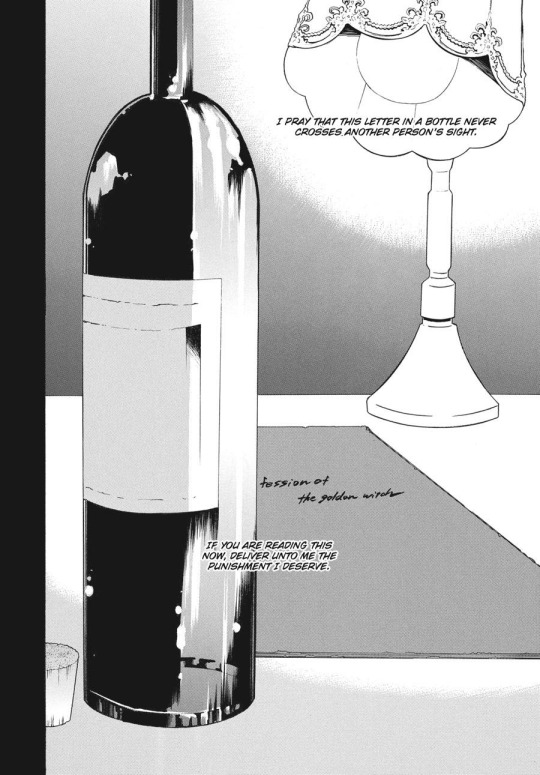
Sayo wrote her forgeries and created her entire murder mystery to confess her crimes and try to have someone understand her feelings. They feel so much shame and guilt over everything that they are incapable of openly confessing to someone about everything and must instead use this oblique method. Even Beatrice never openly confesses everything, no matter how hard she is trying to get Battler to understand her. Even when she must use the red truth to deny witches against EVA, she asks Battler to cover his ears so that he doesn't hear it.
Why would Sayo create this direct confession of everything and then put it into the sea like all their other message bottles? Genuinely... why? They are already writing their forgeries as confessions and want someone to use those to understand them. This is what multiple characters state Beatrice's goal is and also state that someone understanding her will grant her peace/happiness.
The answer is that there is no reason besides a contrivance to:
a. have Ange (and us, the audience) learn about Sayo's backstory without having love to "see" it
b. explain why Ikuko (and thus Tohya) know everything about Sayo to be able to write their forgeries (a lesser reason, but one nevertheless, that also reduces the potential effort Tohya spent to learn more about Sayo by studying her forgeries)
Also, this manga differs from how EP7 frames Yasu as a bodiless being, one without a sense of self who takes on different "roles" - Yasu becomes Beatrice, but is also separate from Beatrice in the narration, speaking of "us" but not speaking of a self as "myself" or "me". They can become their personas, but they are not their personas directly.
In Confession, we see that everyone besides "Sayo" is just an illusion or fake, centering Sayo as "the real one".
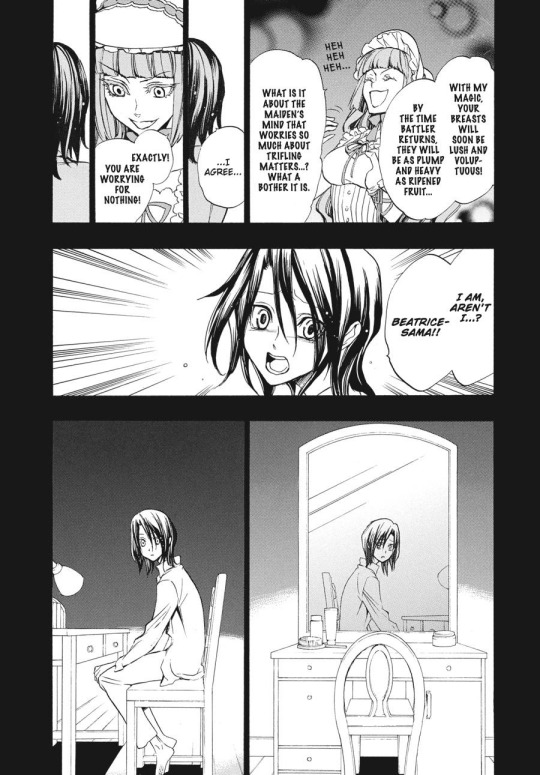
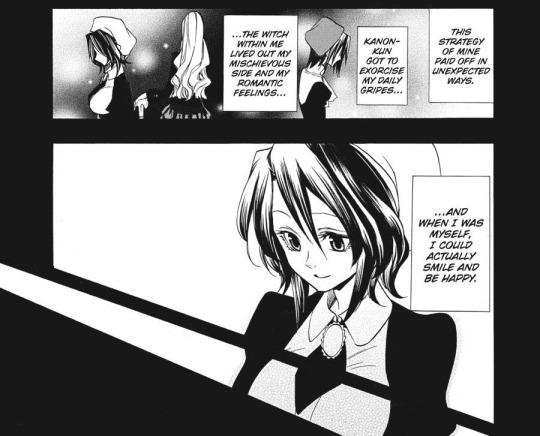
"And when I was myself, I could actually smile and be happy" - implying that Beatrice and Kanon are not her true self, and only "Shannon" is, as Shannon isn't mentioned in the above section.
Another thing is that this chapter introduces more contradictions than just characterization ones. Nanjo mentions that Natsuhi pushed the servant and baby off the cliff.
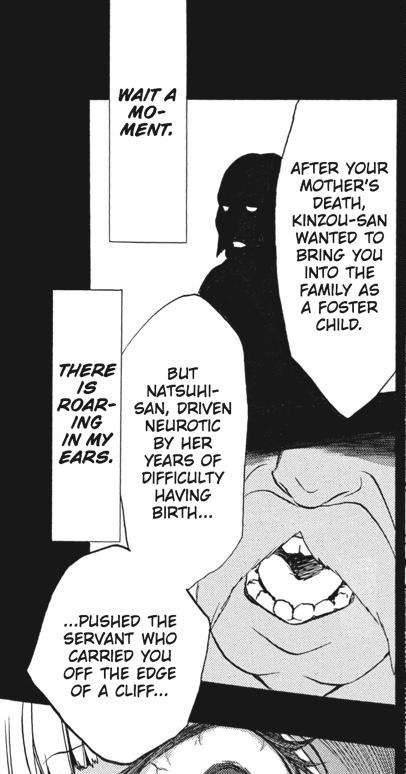
However, how does Nanjo know this? I tried to figure this out, as someone asked me about it on here before. But no one was there at the time. They had to have guessed this, or assumed this, or else somehow overheard Natsuhi talking about it.
Was this line meant to confirm that Natsuhi did, without a doubt, push Lion off the cliff? But this was already pretty much confirmed, given Lion's existence and all the discussion about it in 5 and 7.
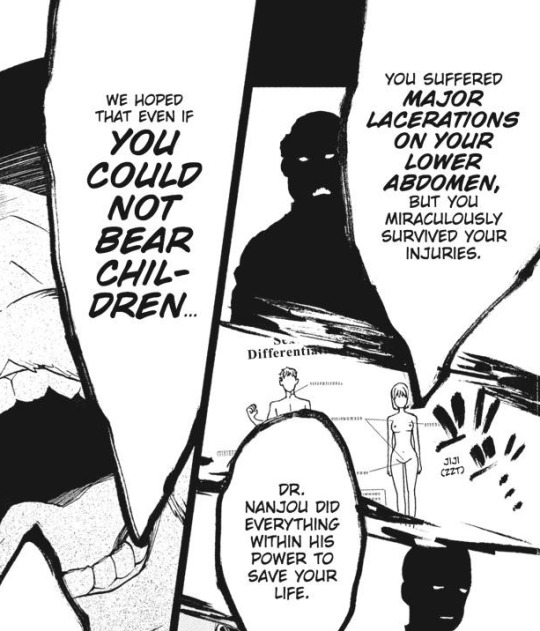
Also, it seems as though it's trying to confirm that Sayo is trans and AMAB, but Nanjo specifically says "though you could not bear children". Hopefully some weird translation thing... on the official translation... (@dainadjakyou checked her Japanese copy and thankfully this is a mistranslation; it's meant to be that Sayo is unable to have children in general).
But otherwise, well. It doesn't manage to even confirm that Sayo is AMAB, whether that line is a mistranslation or not, since if Sayo was born with ovaries and those ovaries were destroyed by the accident, Sayo's body wouldn't produce enough estrogen to have a feminizing puberty, which would be similar to if Sayo was born with testes that were destroyed (not enough T for a masculinizing puberty).
I should also mention that for whatever reason, even though it canonizes the fact that Sayo has a scar on their abdomen, this scar is never depicted despite the fact that we see Sayo's abdomen. Just didn't draw it. So it has internal contradictions, too.
Oh, it does confirm that apparently Jessica didn't know that Kinzo was dead. Somehow.
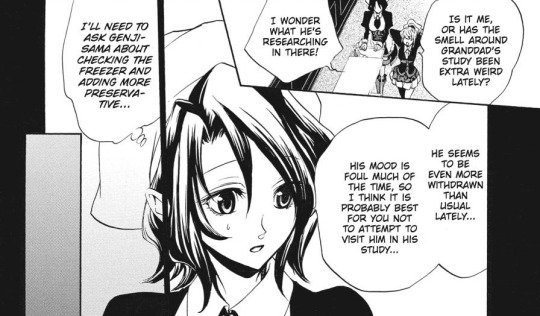
It also tries to confirm or at least more heavily imply that Kinzo was responsible for the Italian/Japanese fighting in EP7.
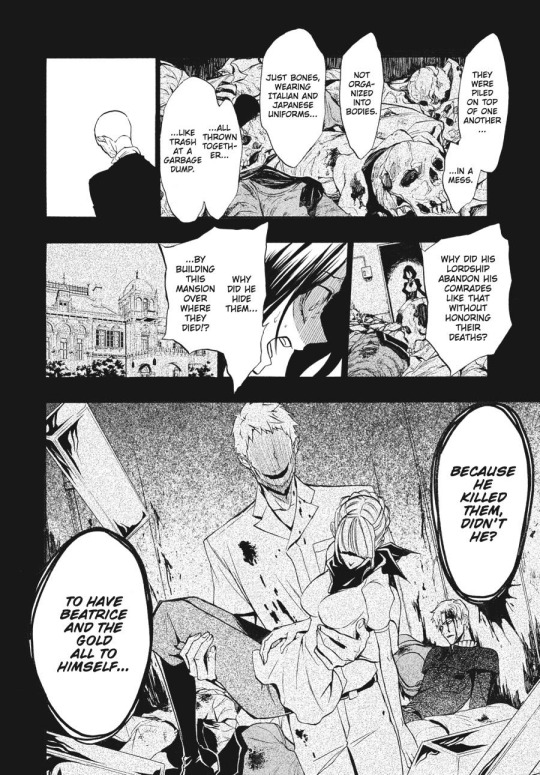
As much as Confession confirms some details, overall it contradicts Sayo's character and other depictions of them in the story while also adding some new contradictions, not managing to properly confirm several things it clearly wants to hammer in, and also contradicts itself at some points due to what I'm assuming is either artistic oversight or poorly thought out stylistic choice.
Opening the catbox didn't need to be this way. And yet, it is.
31 notes
·
View notes
Text
I'm going to word this terribly, but I find Yasu's outlet and the difference of when it is actually carried out to be a very interesting note on the difference between taking out and expressing oneself through a fictional outlet and carrying out one's harmful thoughts beyond that. Beatrice is the endless golden witch with a (seemingly) impossible mystery across perhaps dozens and dozens of messages in bottles metaphorical or literal, and would later be carried on by those beyond her including Hachijo Tohya and Hachijo Ikuko among many unnamed others. Yasu can express themselves and their pain and hatred and even love through fictional mysteries starring their entire family whom most of which don't even know they exist, let alone that they're their family at least in blood relation if nothing else. When they try to carry it out however as they've given up on life or just about hoping that Ushiromiya Battler would solve their mystery however, everyone actually dies horribly and they end up regretting it and likely kill themselves as or after Ushiromiya Eva and Ushiromiya Battler escape. Only one of their mysteries led to death, and it was the one attempted in reality. They never had to feel that regret in any of their previous mysteries for writing them because no one was harmed, and though they at the very least in part meant well and hoped for everyone to reach the golden land in great part out of love, they spend the last moments of their life forced to live with the very real reality of death that in part was a result of their actions.
Then later on even after death, even their fiction in a sense comes into reality and is quite literally experiencing a mass movement of sorts of death of the author. It again was fine when the stories were just an outlet of their continuously traumatized imagination, but now twelve years later it is being treated as simply a work of fiction, divorced not only from the author but from the victims and reality of said victims including not only the author but all of the dead family members. The golden witch survives even after her death or third death when considering Kuwadorian and Bice Beatrice, but without any of their original agency or personal connection or care for those she both loved and hated because the vast majority of the writers are now divorced from it all entirely and only relate to the tragedy via fictional writings they are personally divorced from.
Umineko truly is meta in the actual sense and not the just trying to sound cool or smart sense. There's so many things and ways and levels you can look into it, including from a writing or writers perspective and once again as I've said many times, it is a work that only gets better the more you think about it. Again, sorry if this was all worded terribly, it just popped in my head on a whim.
21 notes
·
View notes
Text
Answers to ask I received in the past (part 2)
As promised I'll try to answer to the ask I received in the past. This is the second group of Ask at which I replied. Please don't send new asks. I won't reply to them.
By the way, these are all Anon asks.
What is the connection between Featherine and Eua?
also
As Featherine under name Eua, which have a form that similiar to Auau aka Hanyuu. Isn't make sense that Featherine is Hanyuu? What do you think?
Sorry, I placed your asks together because they're similar.
You both are talking about the Featherine from “Higurashi Gou” and “Higurashi Sotsu”? Honestly even though I saw the two anime I didn’t look if those Higurashi are ‘official’ as in Ryukishi07 recognized them as part of their canon and I’ve no interest in speculating about it. She might as well be an alternate version of Featherine or Featherine herself when she was younger or whatever you can theorize about. If there was an official answer I didn’t see it.
In “Higurashi Sotsu” Featherine acknowledge Hanyuu as a part of herself. If this is meant to be true in Umineko too or not is something I don't know and that honestly I'm not invested in discovering. Sorry about it.
Why did Ange Ushiromiya Laughed maniacally after learning the thrush about her Aunt?
Laughing is a coping mechanism and when you're overwhelmed or feeling anxiety about something, laughing helps you shed some of that stress and anxiety even if it’s inappropriate. It’s not voluntary, it’s similar to why some people cry when they’re overwhelmingly happy.
It doesn’t mean Ange is evil, just that she’s desperate and on the border of snapping. The manga depicts her as also crying and implies she tosses herself off the building in desperation.
Also tales like inappropriate reactions like this one for the sake of the drama so you might find various tales who use inappropriate laughter as a character response to bad news.
Hey, what is your least favorite character in umineko, mine is kinzo
They’re all well written to me, but I guess you mean which character I think is worse morally and I wouldn’t have him get close to me in real life?
There’s so many to choose since Umineko has plenty of what we could call unrepentant criminals. I probably would feel much safer if none of the adults in Umineko were to get in my own city. They’re all horrible. Traumatized but horrible.
Do you think that Ikuko Hachijo developed romantic feelings for Tohya Hachijo (Battler) throughout spending her time with him?
I would say yes, if it wasn’t for the fact that I’m a strong Battler/Sayo shipper and so I prefer to think they just like each other as friends. Likely though the idea is that they love each other, if they do in a platonic way or if they merely didn’t marry because Touya has no real identity to speak of is up to speculation.
This may be an odd question, but it's there any panels in the Umineko manga of Ange showing the buttons on the shirt she wears under her jacket?
I have no idea but you can find the manga on manga scanlation sites and check it yourself if you’re really that curious. The manga is good and worth reading so I recommend giving it a look.
Is Bernkastel an actual complex character? Or just a one dimensional monster? Also would you call her edgy?/Is Bern an actual complex character? Or is she just a sadistic heartless monster created by Rika's pain? I was hoping she could have been like a grey character, rather than pitch black, but i guess i had wrong assumptions on her
I put those two asks together because they seem the same. Bernkastel likes to play the part of one dimensional monster but she’s a complex character and I’ve plenty of post discussing her if you’re interested. Also consider that the meta world has different ethic values compared to the real world so things are a lot more complex than what they look like on the surface.
Is there ever a reason given in the series for why Yasu was raised female even though they were AMAB? It's not like the older servants just guessed their gender, they all knew Kinzo had a secret son. I know they lowered Yasu's age to hide their identity but I don't know why changing their gender would help, especially since it's such a huge problem for them later
No, there’s not a reason given in the series. I’ve been told though that in Japan this was a thing that was done in the past to kids with ruined genitalia. Take it with a grain of salt though as I don’t really know exactly how this worked.
Hey, I just saw your post about other selfs in Umineko and I gotta say, it has helped me a lot lol, im not the same person who asked you, hell i dont even know english that well but as someone who has gone through many identity crisis due to my gender and other stuff and the only way to cope is creating this self on the internet to feel accepted is, yeah i can see i was just like Sayo and I was just running from reality, hell ive been running ever since my best friend left me, so, yeah thanks (?
I’m really happy if my post was of some help! Thank you for letting me know!
Has anyone asked about Kinzo’s test in episode 4? We know Maria solved it somehow, but then what is the solution? What could she have said to earn such favor?
We know the solution Kinzo chose when he met Beatrice was to kill everyone else to obtain his own life and the one of Beatrice (his loved one). We can see it implied in Episode 4 Volume 4 Chapter 16 of the manga and we see it being shown in Episode 7. Maria likely chose the same, to kill everyone else to save the person she loved. If said person was Rosa or Sakutarou (in episode 4 Maria had a bad break up with Rosa) that’s up to speculation.
Can you recommend more visual novels like Umineko?
Sorry, I’ve only read Umineko and Rose Guns Days so I’m not the right person to ask about this but people say Higurashi is good too.
3 notes
·
View notes
Text
Umineko EP3. Replay Part 5
Well yeah Battler, you got it! How did the other Golden Witch get her powers then?
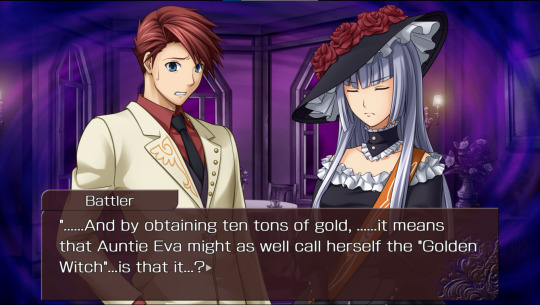
lmfao owned.
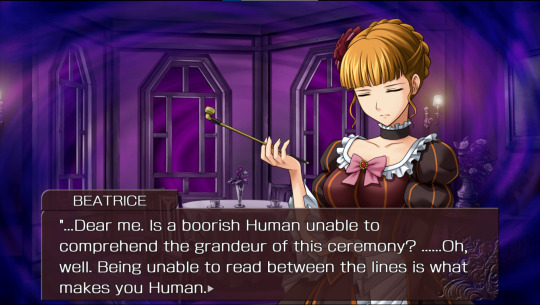
Man Virgilia and Ronove really spoil Battler with all the hints.
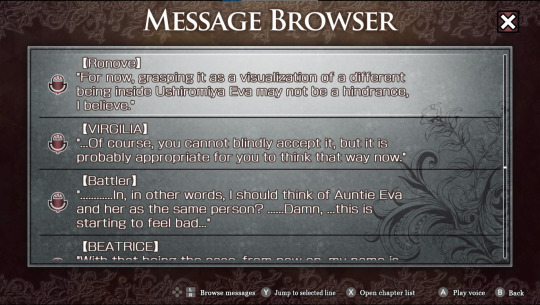
Rosa and Eva speaking in code is pretty good, neither wants to leave the room without the other....
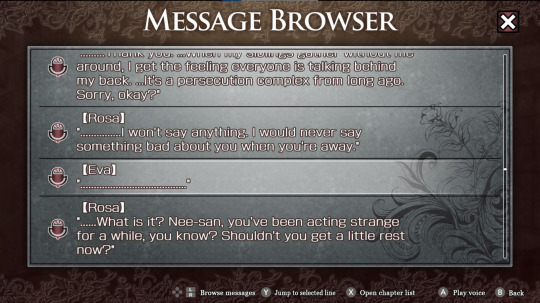
The fact Rosa shakes a bottle in frustration in trying to find something that isn't there while being angry at Maria for being mad that something isn't where it should be is pretty ironic.

Obviously this scene didn't literally happen and something closer to what actually happens is something like Eva telling Hideyoshi about the gold and her plans and etc while being disgusted by her own greed, while at the same time going deeper into it....
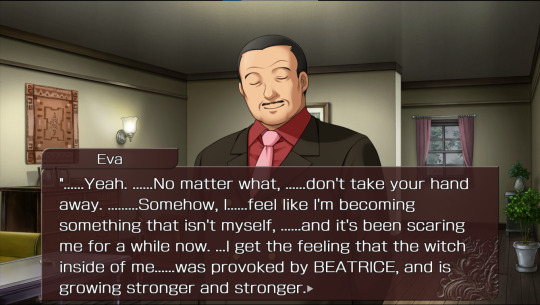
Maria's random insistence at this to me seems like a sign that this is something Yasu and Maria had pre-planned. If there was a deadlock taking place, she would cry about her rose, similar to how she used the cards to break deadlocks in episode 1 and 2. Though I don't think it would work like they intended this time if Eva didn't like, fuck things up her own way.... I don't think Yasu would murder Rosa in front of Maria and I don't think she would like, shoot Maria either....
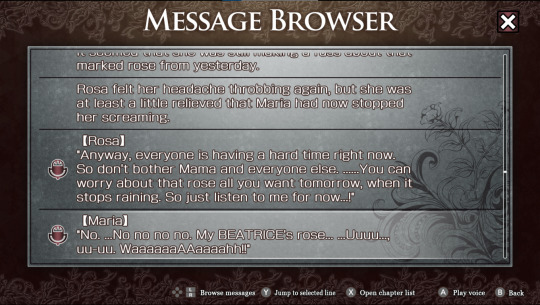
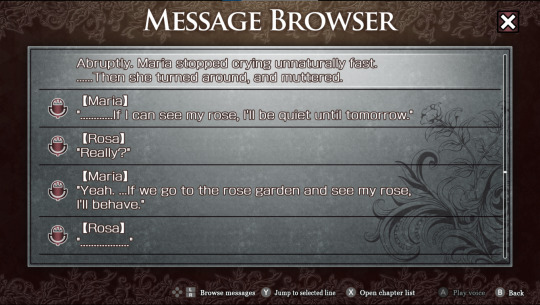
Well.... obviously the truth is something in between here. Eva may not be enjoying tutoring Rosa at this moment, but she is surely having a fight with her about keeping the secret with her, and pushing her into the fence in frustration.... and then murdering her daughter to leave no witness. Granted, I don't think Eva would just go on a murder spree normally.... I think of it as something kind of like Meakashi Shion. The murders wouldn't have happened if the first accident didn't.
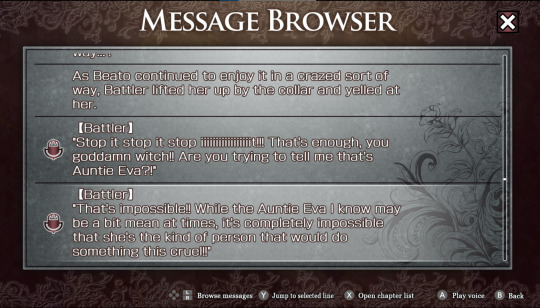
I.... forgot Battler just tells her to kill herself omg.... this scene is kind of interesting. i am kind of interpreting it as what Yasu was scared Battler would think of her when she found out about her murder mystery plans... we know from episode 8 manga that he is all things considered pretty forgiving of it, in actuality. But I could see Yasu thinking this is how it would go down or even what went through his head at first before stopping himself and thinking of what led to it. Also Beato will get to get her wish of seeing what Battler cooks in episode 8!
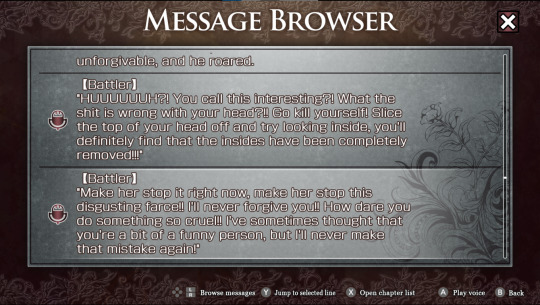
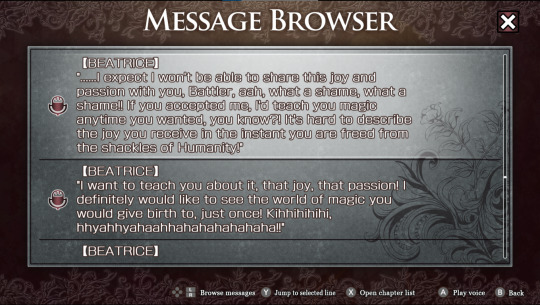
Of course she is exaggerating for her trick strategy, but I don't think this is too far from what she thought about herself, either, and it's not like she wasn't cruel with her pranks and stuff so it isn't entirely unwarranted, but...
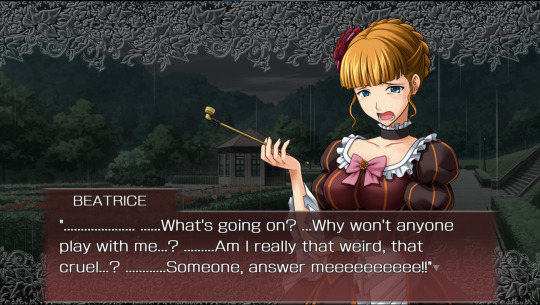
I imagine she probably did apologize to Maria something like here when she found her corpse and had to fix it up, too....
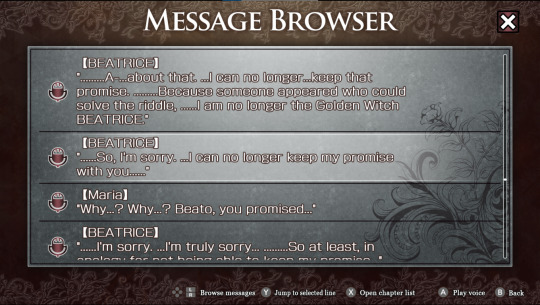
Obviously, though, you are supposed to be very sus of Beato here lol. I mean she turotred Kanon like, a couple hours ago lol.
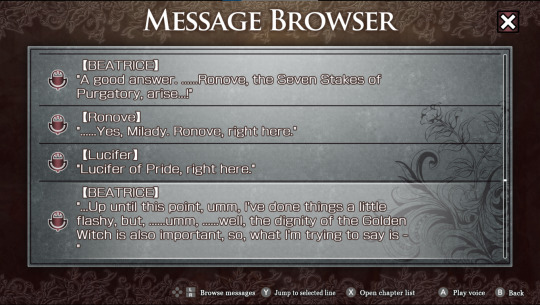
It's really funny how it seems this specific act didn't really trick anyone lol - sorry Yasu I guess you kind of failed.

There is a clear difference in my view in how the family acts towards the murder in this episode and the last one. In this one they more or less figured out both this and the first murder - compared to how in the first 2 episodes everyone was clueless. I think in universe you can justify this with there being more servant deaths and therefore less culprits to worry about and also you can theorize that Yasu assumed her plan would go without a hitch - something Tohya knew wasn't true.
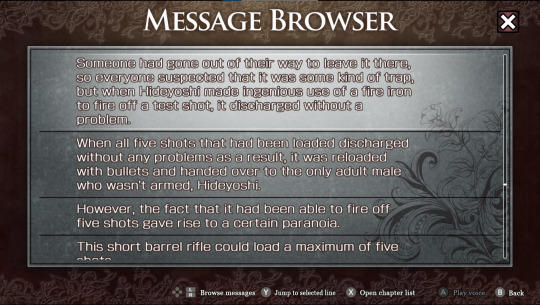
Eva's desperate to throw suspicion elsewhere lmfao.
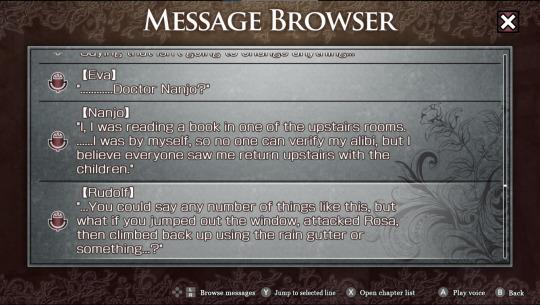
tldr people don't believe in magic anymore so to make them believe it you have to make very obtuse murders.
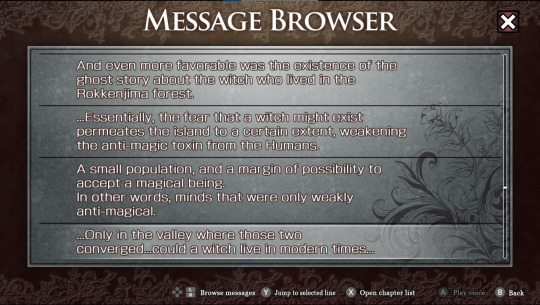
It is kind of funny Hideyoshi doesn't realize what is going on even though it is decently obvious, lol. Also, Natsuhi is freaking out because their reasoning is stupid - and I mean it is if you take it at face value, maybe you should have thought about it Hideyoshi!
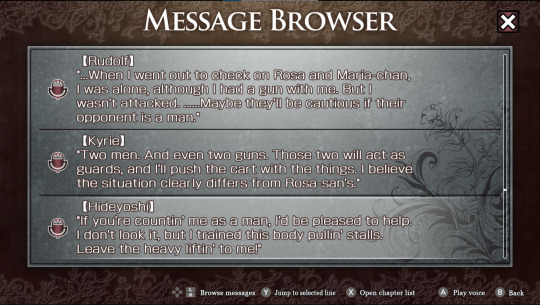
"Until that question could be dealt with, the only answer was[...] magic" Is an interesting line. The answer to this sequence of events is obvious, Kyrie and Rudolf are luring out Hideyoshi.... so if this is framed as magic, it tells you how magic is used in other situations, and to go back to other magical scenes and see what you can take from them.
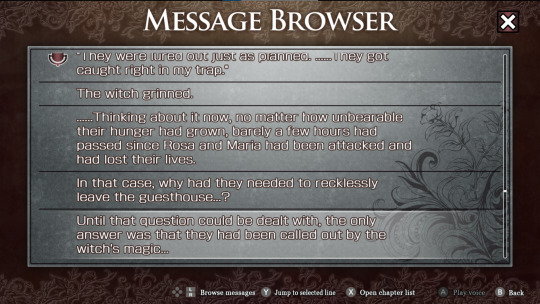
I kind of wonder how Hideyoshi was able to kill both Rudolf and Kyrie, especially at such a disadvantage. I guess he didn't come unscathed, though, considering he died. So it could be as simple as a bullet missing. him or him attacking before Rudolf and Kyrie were ready.
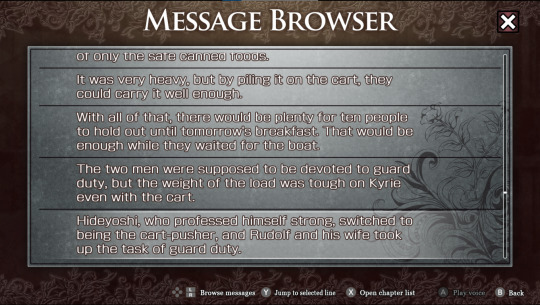
Uh huh, Kyrie... you can tell both this was written by someone with love for Kyrie and Rudolf and that they are someone who knows Kyrie might uh, have some issues.
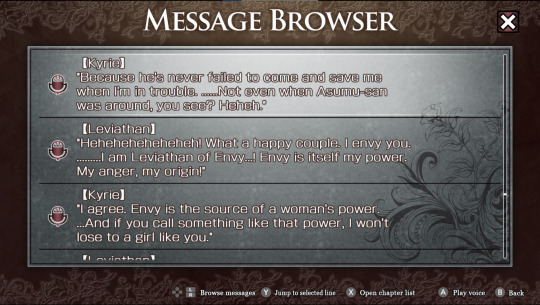
To be honest, I originally took this to mean Eva literally did show herself and caused the shootout where she was the one survivor when I first read it... I guess I was being too literal when I read this for the first time. It's more of a general representation on Eva's complicated feelings towards her family, the gold, etc coupled with her fucking up the board.
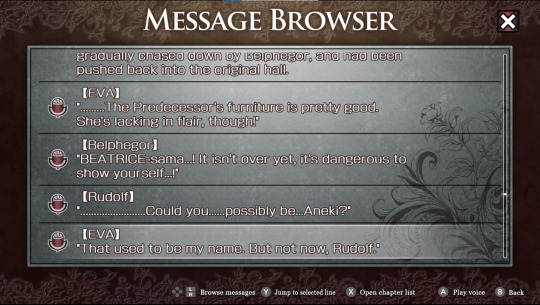
Kyrie is more or less wrong about everything she says here, Rudolf was not in any remote way cornered, in fact if anything he was cornered *towards* dating Kyrie and he still picked Asumu. Kyrie was never anything more than Rudolf's side and they only ever got together officially because Asumu happened to die. To be honest I can't exactly blame rudolf for thinking Kyrie would kill him for revealing the truth.... he would in fact kind of deserve it.

I kind of want to use this scene to springboard to talk about misogyny in Umineko in general - specifically the ones experienced by the mothers. This entire chapter is basically an essay on how Eva faces misogyny, Natsuhi was basically sold and used as a womb, Rosa was left by her husband and forced to deal with how society treats single mothers, Kyrie has shit with her family as well as Rudolf both depending on her while using her as a side piece and feeling emasculated by her, etc. really all the women in Umineko are greatly affected by misogyny. And since Umineko deals a lot with generational trauma and cycle of abuse that is also how misogyny is passed down in Umineko Eva yells at Natsuhi about how she is just a womb, tries to use the fact George is male and Jessica female to steal the headship from Jessica, and that's even before the awful way they treat Shannon. Natsuhi refuses to engage with her daughter as a full person with a variety of interesting and own personality and instead tries to mold her into a "proper" and "modest" woman. Rosa tells her own daughter she is the reason her father left and blames her for the people she is dating not wanting to deal with her. And finally, Kyrie throws endless shit to Asumu and basically has a headcanon about how Rudolf is blameless and Asumu was just a homewrecking whore who got in the way of her and Rudolf, when Rudolf is obviously the one at fault. I don't want to make it look like I am saying these are basically the same characters or anything like that, there is a lot of difference in motivations behind why they do this, in how they cope with it, etc, but I mostly discuss that in other posts so I don't want to go into that much details. I think Umineko overall deals with misogyny in a good way- it understands that misogyny isn't just a Big Bad Old Fashioned Man you have to defeat, and afterward misogyny is solved, it isn't something you can just defeat by just changing the way you think or whatever but a system built in favor of men that gets internalized by everyone, including women, and that those attitudes are internalized and passed to the next generation before they can so much as even talked. This is a little bit of a tangent but related to how all of the characters previously talked about are both victims and afterward abusers or otherwise people that harm others, I am happy that WTC works in general aren't shy of showing how abuse can be internalized in bad ways that cause harm to others while still holding sympathy and space for the victims. A lot of works are scared of this because if done wrong it can look like victim blaming or ignoring victims in favor of abusers, but I think works like this are really important for victims to understand that some imperfect behavior after being abused is normal and that they aren't irredeemable and can grow themselves if they ever fail and do bad things. holy shit I went on a huge tangent. I haven't played in like 2 days because I got the idea to write this 2 days ago and have been workshopping on my brain how to word it.
Anyways back on regularly scheduled Umineko, it is kind of funny how the first time humans really 'win' against magic it's not really presented in a positive light. They won because their vices were even worse than the vices of the stakes representing sloth and envy.
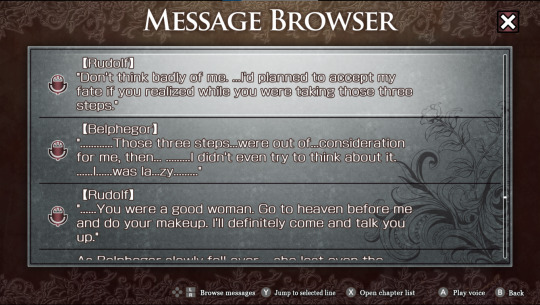
Beatrice struggles about dancing around the fact she just wants Battler to acknowledge her for her own sake, lol.
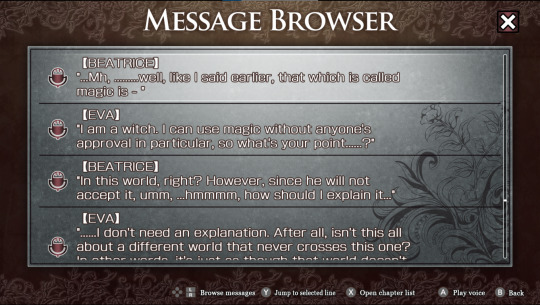
they have hinted like 10 times that the chiester sisters = gun in the last like 20 lines lmfao.
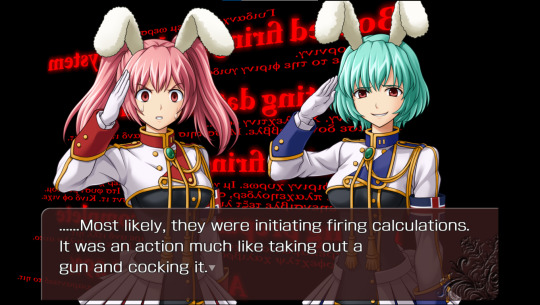
They are dropping a bunch of hints towards what Beatrice actually wants here. The awkward conversation with EVA meant the same thing more or less too.

This scene's interesting - I am sure Hideyoshi in actuality DID feel Eva was being changed by the gold into a crueler person but everything points towards him being pretty enabling overall. Also Hideyoshi hints towards magic and witchdom being about being unable to deal with the past. Also there is a line that says "The gun near rudolf killed Hideyoshi (paraphrasing) which is kind of interesting considering the manga says it was Kyrie instead.
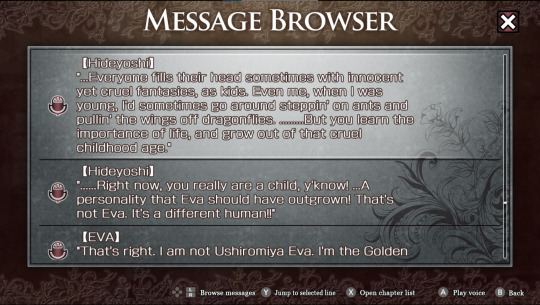
The fact Eva is freaking out this much about Hideyoshi going outside - even before she knew that Rudolf and Kyrie followed him is a hint that she was recruited, I think. After all, when talking with Rosa she said she thought the original murders were a prank, and she was the one that killed Rosa and Maria so.... why is she freaking out now?
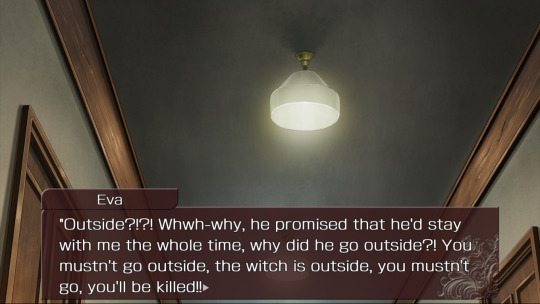
Ok yeah - she's using Yasu keywords like 'Golden witch" and witch in general on a nonfantasy scene. Definitely some hints towards that I think. i didn't catch that Eva was an accomplice in this episode until I read the manga, to be honest. Thought she'd just murdered people on her own. Definitely didn't trust Yasu at all though, didn't even tell her she found the gold.
7 notes
·
View notes
Text
Umireread: Turn of the Golden Witch - Chapter 8: Wedding Ring
Sat, Oct 4 1986 - 10:00PM
The following contains spoilers for the entirety of Umineko. Please do not read if you are yet to finish it.

I know this isn’t the first time that Santa has been brought up in relation to fantasy vs reality, but it is a pretty apt comparison for the message of the story. No-one ever says that it’s cruel or immoral to lie to kids about there being a magical man who delivers presents around the world. If it wasn’t for the fact that they have to learn the truth eventually - since they’ll need to help perpetuate it for the next generation - would it be better if they spent their entire life believing it?
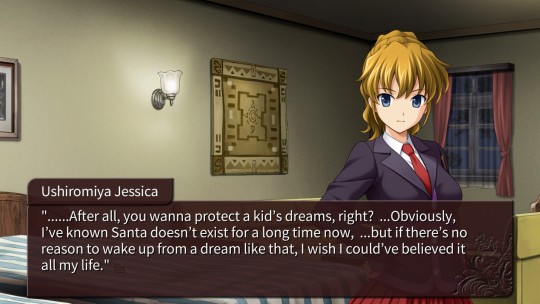
Case in point.

It’s interesting how much time they’re devoting to setting up devil proofs here - priming us for the introduction of the Red Truth and showing how many issues we’d have trying to solve the story without it.

Come on Ryukishi, you can’t just say “wow! I’d love to read a story about a child seeking revenge!” in your story about a child seeking revenge.

Episodes 1 and 2 dwelling so hard with the incorrect axiom of “the killer doesn’t want to be caught” really torpedoes the arguments that the characters are able to come up with. By now, it should be pretty reasonable to figure out that the killer wants to be caught - and that they want the Epitaph to be solved. But why? Is it possible to even construct a plausible theory for that at this point?

This scene is just oozing in the overall truth, isn’t it?

Very funny to see that “human woman” is in bold here, but not “single”. Don’t want to make the regular accomplices and the resulting roulette too obvious now. I’m sure Yasu is pleased to be perceived as a human woman, though.

You know, I’ll have to see how much this facet of Maria’s personality remains in the Tohya Forgeries, because this really isn’t doing it for me - and I’m wondering how much of it is down to this being Maria’s actual personality, and how much of it is down to Yasu focusing on that element of her.
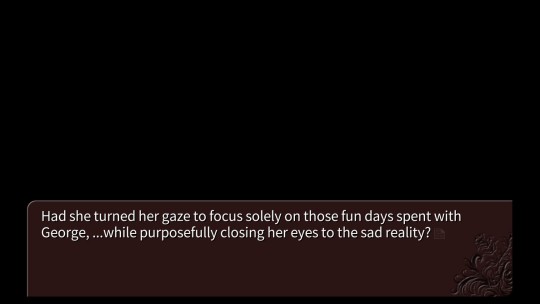
No comment necessary.
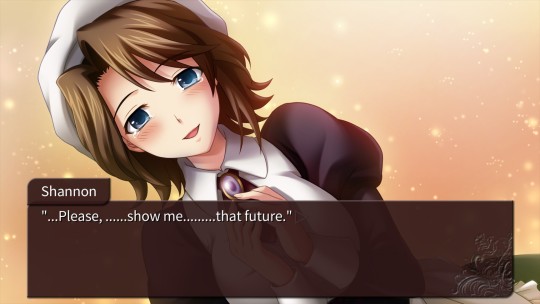
Echoing my former comments on how, regardless of how their relationship formed, you can’t deny how much it means to her.
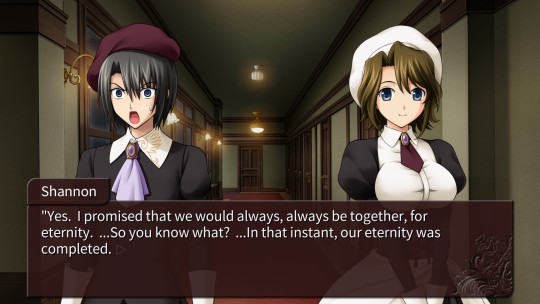
Shannon’s use of ずっとずっと here made my ears prick up - admittedly due to the immense amount of times that I’ve listened to Revelations. While it’s definitely too much of a stretch to link these together, I do find it interesting how the phrase is used here for “always, always” yet in Revelations it’s used as “again and again”. Of course, the latter translation is meaningless nonsense if you think of a single gameboard - but if you think about it over the wider Sea of Fragments?
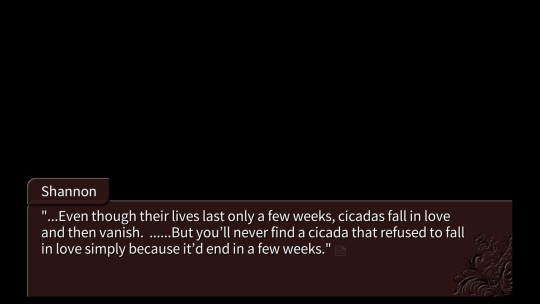
This is really interesting to compare to the philosophical discussion of the life of the wilting rose in Episode 1 - all the cousins talk about their thoughts on seeing the rose, being glad they could see them when they bloomed, but here Yasu is the one considering not how she feels about the Cicadas, but how they feel themselves. And isn’t that the actual important part of it all?

Okay - so this was going to happen eventually, but now is as good a time as any. Allow me to chime in on Umineko’s central theme of “love” as an asexual person.
I’ve alluded to how you can interpret Umineko as a criticism of heteronormativity before, but even at the core, Umineko is intrinsically connected with the base human instinct of love. I’d go as far to say that Ryukishi (at least, at the time of writing) wasn’t really aware of asexuality, and just assumed that experiencing love was a base part of the human condition that everyone experienced. Mildly amusing if so, since it means he too has fallen victim to building arguments on flawed axioms, while writing an entire tale about that very issue.
However, even as an asexual… I don’t mind this. I don’t feel seen by Umineko, but there’s a key component to how Umineko has been written that stops it from being entirely unrelatable: while Umineko dwells in romantic and sexual love, Ryukishi is writing with unrestrained love towards his fellow human beings. He’s writing with love towards the world he was born into. The world that we were born into. While he may not have done so intentionally, platonic love oozes from his work.
That’s why I can still resonate with the central message. Maybe I don’t love anyone in the way that Ryukishi expects I should. Maybe my body, too, is effectively furniture. But even still, I can love my fellow human for existing. I can love the joys that we can experience because we are alive. I can say thank you for being born - not just to others, but to myself. I can relate to that. And, honestly - I think everyone can. Maybe romantic love isn’t something that everyone can or will experience. But a general love to the world around them? I do think that might indeed be a universal part of the human experience.
…I’d love to leave this little aside there, wrapped up nicely in a bow, but I did have a bit of a gut punch at the “maybe I too am furniture” note - because, yeah, in hindsight, that might be directly aphobic. That might be the line that’s devalidating to asexuals. But, again, I don’t personally have a problem with that, because that concept is directly stated to be Yasu’s line of thinking - not a view that finds itself entirely endorsed or condemned by the narrative. Because it’s just what she thinks - and it’s up to you to decide how you want to feel about that. Yasu is hurting, her beliefs come from a place of trauma - I don’t feel invalidated by that. I just want the person who believes that to become better, to heal. I want to be able to love the human who lies behind that layer of unmitigated despair and agony. And, again, isn’t that ability to understand what Umineko is about?
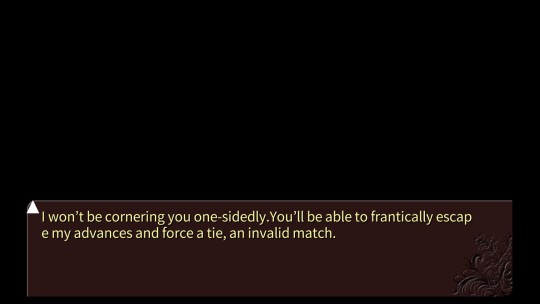
Once again, moving swiftly on from a deep dive to a more regular point of analysis. The concept of a “tie” in Beato’s game is an interesting remark - because how would that happen? Of course, with full knowledge, this is a board state where Yasu is caught and apprehended (all it takes is a lucky shot from one of the guns), but the Epitaph is not solved and the bombs still go off. But, if you don’t know that, how does a tie work in this game? You catch the culprit or you don’t. So this is a pretty strong hint towards Beato having a failsafe.
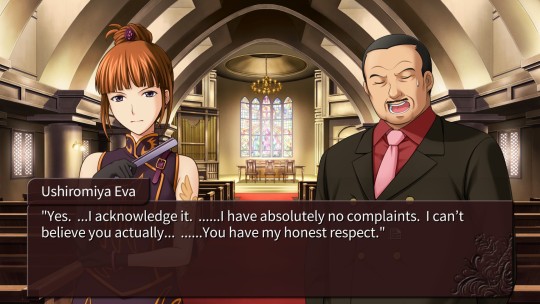
This is one of those scenes where I’m deeply curious about what’s going on behind the scenes. How much did Yasu reveal to the adults here? We know the chapel is connected to the secret room, so it’s very possible that she straight up showed them all the gold.
Actually, thinking about it, there’s an alternate solution for the First Twilight here, isn’t there? You could actually Red Truth that the door was locked, since we could have got in/out via the underground passage to Kuwadorian. Although of course, that doesn’t play nicely with Knox, even if we allude to the presence of a secret passage with the code in the chapel.

I’m going to be honest, I don’t actually remember them doing Role Calls after Episode 1. The first one stuck out to me a lot, but I guess the repeats didn’t leave as much of an impression.
No Kumasawa, Shannon, or Nanjo this time. Very interesting - we already know that the Role Calls are untrustworthy since we have Kinzo in the study, but even if you wanted to say “but that’s just his body”, we have Kanon in the corridor and Beato in the VIP room, so that’s an impossibility there. I’m going to rescind my Episode 1 remark about the missing people being those who are sleeping, and just flat out say that I don’t have any reasonable conjecture on why the people who aren’t in the Role Call are absent from it. Natsuhi’s absence in the first Episode torpedoes the idea of it being accomplices. Could not give you a single theory that connects these missing pieces together.
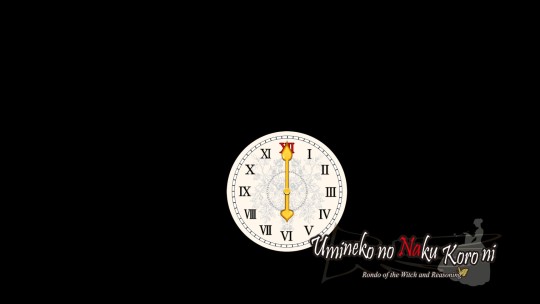
And time for the First Twilight… for the second time.
3 notes
·
View notes
Text
Tohya and Yasu would find eachother in any anonymous furry roleplaying forum
5 notes
·
View notes
Text
Detective Erika Furudo’s Serious Deduction6
Chapter of Erika Furudo’s EP2 Deductions
Is the Second Game a Forgery or a Message Bottle?
Let’s move on to deducing the second game. In the theatergoing layer, there are two opinions about the second game: it’s a message bottle retrieved by the police, or it’s Tohya’s forgery. The prevailing theory seems to be the message bottle. The distinction between a message bottle and a forgery is hinted at in the story. Let’s examine those clues specifically. First, according to Professor Ootsuki, the contents of the message bottle “start from the day before the incident, have all 18 people dying as a common point, and differ in the details of the incident.” The first game matched exactly what Professor Ootsuki described. However, the second game starts with George and Shannon-san’s date trip. It doesn’t begin the day before the incident. This creates a contradiction. As for Tohya-san’s forgery, the narrative states that “Banquet is Ikukuro Ito’s debut work,” referring to the third game. The tricky part is that it says “Ikukuro Ito’s debut work” rather than “Tohya’s debut work.” This is problematic because, at the start of the sixth game, it’s revealed that “Tohya Hachijo won awards simultaneously at multiple publishers under different pen names,” meaning Ikukuro Ito might not be the only pen name for Tohya-san’s forgeries.
Ultimately, this can’t be conclusively determined from the clues. Let’s try deducing from another perspective: the presence or absence of the meta-world. In the second game, magical depictions appear, such as the Seven Sisters of Purgatory and Beatrice herself (in the dress). These are so-called fantasy depictions. As deduced in the first game, these fantasy depictions are narrative tricks premised on the story being a “story within a story.” Since it’s written from the subjective perspective of the in-story writer, there’s no “guarantee of an omniscient perspective.” When reading a novel written by an in-story writer, you have to doubt their personal views. In other words, even if Writer A depicts magic, it could still be “interpretable as a mystery in the setting.” In a typical novel, third-person narration is objective fact, and depicting magic would confirm its existence. Saying “it was actually a lie” wouldn’t hold up logically. This work, however, uses a narrative trick where “even the third-person narration is subjective.” So, magic is written in the original text. If it weren’t, a logic error would occur, making it impossible to think in mystery terms. There’s no room for debate here.
So, Writer A, who wrote the second game, introduced Beatrice-san. She appears during Shannon-san’s murder, for example, depicted as killing with magic in her dress. This Beatrice-san is likely the same as the meta-world character who’s presenting the game to make Battler-san remember the promise. In terms of narrative continuity, the meta-world is probably written in the original text too. This ties back to the deduction from the first game about “Tohya-san’s apology to Yasu-san.” Through the meta-world story of Battler-san and Beatrice-san’s deduction battle, Tohya-san is apologizing to Yasu-san in heaven. When chained together like this, it feels highly likely that the second game is Tohya-san’s forgery, not a message bottle. Since Ikukuro Ito’s debut forgery is the third game, it might be written under a different pen name or an unpublished manuscript. This can’t be confirmed at this point, so let’s put it on hold for now.
The Overwhelming Amount of Romantic Description in the Story’s First Half
The second game heavily depicts Shannon-san and Kanon-san’s romances in the first half. The sheer volume of text is staggering. The fact that the questioner dedicates so much text to this is a significant clue for a detective. In a mystery, the questioner doesn’t write meaningless scenes. Everything is a foreshadowing, related information, or deduction element for the mystery. The romantic descriptions from the opening to before the incident are a metaphor for the story’s essential truth. Shannon-san, Kanon-san, and Beatrice-san are the same person. It’s suggesting that this single person is in love with different people. The focus is on Beatrice-san, who, before the incident, helps fulfill Shannon-san’s love. But during the incident, in the locked room of Natsuhi’s room where Shannon-san is killed, she acts strangely. Beatrice-san was genuinely furious about Shannon-san’s talk of love. The root reason for her attitude is, “I’m causing this incident to be with Battler, and you’re getting cocky just because your love is already fulfilled, you jerk!” In short, Beatrice-san got pissed off. Come to think of it, Beatrice-san was told to wait for Battler, carrying her love for him, but Shannon-san is all cheerful starting a new love with George. Of course she’d be irritated. It’s like, “What’s your deal?”
The Witch’s Eyewitness Testimony
At the first day’s dinner, Kyrie and Rosa testified they met Beatrice. It looked like it was heading toward a serious discussion, so Battler and the other kids were told to go to the guesthouse and left. The Beatrice that Kyrie-san and Rosa-san saw was in a suit, not a dress. This is a clue from the questioner. It’s likely meant to distinguish the fantasy Beatrice from the culprit Beatrice. In other words, this eyewitness testimony is true. The key point is that Kyrie-san and Rosa-san didn’t think this Beatrice was Shannon-san. They recognized her as an individual, Beatrice. This is the same as how Shannon-san and Kanon-san are recognized, but in the fictional world, the higher-layer writer’s authority forces them to be seen as separate people. That’s Tohya-san or Yasu-san. The game board world requires deducing tricks, including the real-world layer. The same-person trick can’t be solved by looking only at the game board world, so caution is needed.
First Twilight: The Locked Room Murder in the Chapel
Now the incident begins. Exciting, right? Hehe! On the first twilight, Rudolf, Kyrie, Krauss, Natsuhi, Eva, and Hideyoshi were killed in the chapel, their stomachs ripped open vertically. Candy was stuffed in their stomachs, and a witch’s letter was left. I love this gruesome scene. Mysteries are entertainment, after all, and I want to be shocked. Surprises! I just love gory scenes so much. I get all “whoa!” but Battler-san was furious. What’s with him? Our sensibilities don’t quite match here. Beatrice-san says a lot of red truths, but since the trick itself is ridiculously simple, let’s ignore the red truths. Will-san’s deduction is enough.
“Let’s continue. Second game, first twilight. Six people with ripped stomachs in the locked room chapel.”
“Illusion to illusion… The golden truth locks the illusion’s bolt.”
The locked room was a lie, collusion by accomplices. The chapel wasn’t locked. At the scene, Rosa, Shannon, Kanon, Gohda, and Genji were present, but no detective. There’s zero objectivity. None at all. It’s a free-for-all of lies. What was the detective doing, anyway? While murders were happening? Just sleeping normally. If it were me, I’d stay up all night monitoring the entire mansion. The atmosphere was screaming that an incident was coming.
I have a thought about this. The root cause of the chapel’s locked room is that Rosa-san tried to open the door and couldn’t. Normally, you’d think, “Oh, it’s locked.” But since this story lacks narrative objectivity, that description itself could be a lie. So, there’s no contradiction in the trick. However, when the narrative does this, even the foreshadowing presented as clues could be lies. That’s the problem. In a mystery, the truth can be identified with presented clues, but if you have to judge whether a clue is “really a clue” or “a fake clue,” identifying the truth becomes extremely difficult. You can only rely on the detective’s subjective judgment.
Regarding the chapel’s locked room, I’m very interested in how the victims died. Their stomachs were ripped open, but what’s the deal? What’s the direct cause of death? Ripping open a stomach out of nowhere would be unpleasant even for Beatrice-san, the murderer. Even if we assume sleeping pills were mixed into the food, getting your stomach ripped open would make you scream, “Argh!!” So, maybe they were shot in the stomach first to kill them, then ripped open to hide the gunshot wounds? I think about this a lot, but Beatrice-san, the questioner, only gives hints about the locked room trick! I get her feelings. She wants Battler-san to notice the lie in the incident’s trick, so she focuses on the locked room lie. But that doesn’t mean she should ignore the other parts! It’s driving me crazy! I’m sorry for trying to marry Battler-san in the sixth game, so please give me a hint! Should I visit the Golden Land next time? Will they let me in? The door’s already closed, though.
Second Twilight: Jessica and Kanon’s Locked Room Murder + Kanon’s Missing Corpse
Witnessing her parents’ deaths, an enraged Jessica-san goes to the VIP room where Beatrice is supposed to be. Gohda and Kanon follow. Unable to find Beato, Jessica-san returns to her room, accompanied by Kanon-san. When Battler-san, Rosa-san, and others notice Jessica’s delay and go to her room, Jessica-san is found stabbed in the back with a stake, dead. Kanon’s corpse is missing. The key to Jessica’s room is found inside, and Kanon’s master key is found in Jessica’s pocket. Here’s the thing: Shannon-san and Genji-san said they were summoned by Kinzo for clerical work at the same time, but Kinzo was already dead before the game started. That’s a lie. Since Shannon-san and Kanon-san are the same person, this relates to the sequence where Kanon accompanies her. Jessica-san was stabbed in the back with a stake. This likely means she was shot, then a stake was driven into the gunshot wound. The back. Someone close, whom Jessica-san turned her back to, killed her. Probably Shannon-san, right? The culprit is Beatrice-san, but it might have been done in the form of looking like Shannon with Beatrice inside. Kanon-san’s personality is killed at this point. The room is locked with Shannon-san’s master key, completing the locked room. Naturally, since Shannon-san is alive, Kanon-san’s corpse doesn’t remain.
From the second twilight, Rosa-san controls everyone’s movements. Suspecting the servants, Rosa banishes Genji, Kumasawa, Shannon, Gohda, and Nanjo to another room. Good! That was the right move! Rosa, Battler, George, and Maria barricade themselves.
Rosa-san Is Cute
By the way, Rosa-san is cute, isn’t she? Marrying her comes with the adorable Maria-san as a bonus. That’s awesome. Why is she struggling so much? I love Rosa-san. Next to my master, of course.
Seventh and Eighth Twilights: Nanjo and Kumasawa’s Murders and the Locked Room Corpse Disappearance
I got sidetracked. In the servants’ room, an injured Kanon-san appears and kills Kumasawa and Nanjo. The surviving Genji, Shannon, and Gohda report to Rosa, and everyone goes to check, but Kumasawa and Nanjo’s corpses are gone, and the room is a locked room. Well, Genji-san and the others say a lot, but the detective didn’t confirm it. They were acting separately in another room, so it’s not trustworthy. Anyone but the detective could be lying. Kanon-san is dead, so he can’t be witnessed. These people are full of lies! As an honest person, I find it questionable!
Now, about this murder. The part where Kanon-san appears and kills Kumasawa-san and Nanjo-san is likely a lie, but how was the crime actually committed? Gohda-san is here. Committing a murder in front of him might make him uncooperative as an accomplice later. So, for the corpse disappearance trick, they probably had them move to another room. Maybe Kinzo-san’s study? Then, they created signs of a struggle in the servants’ room and reported to Rosa-san. The question is, when were Kumasawa-san and Nanjo-san killed? After reporting to Rosa-san, George, a non-servant piece, joins the servant group, restricting culprit Beatrice-san’s free movement. This means either Genji-san killed them while they were going to get the spiritual mirror from Natsuhi’s room, or Beatrice-san killed them at the destination after moving them and returned as if nothing happened. Various deductions are possible, but there’s only one correct answer. Which is it?
Let’s look for clues. Nanjo and Kumasawa are identified as the seventh and eighth twilights from the stakes. The sequence suggests that the locked room in Natsuhi’s room comes after, but it’s labeled as the fourth, fifth, and sixth twilights. So, the killing order is likely after the locked room in Natsuhi’s room. This makes Genji-san very suspicious. He’s also the one who discovered the corpses. There’s a sudden description of Genji-san stabbing a butterfly with a knife, which feels like a forced clue. I think that’s a bit much! Do it elegantly, please. Elegantly. Well, from the presented clues, the deduction is that Genji-san is the perpetrator. In red truth terms, he’s likely classified as an “accomplice,” not a “culprit,” so it doesn’t conflict with Will’s red truth about servants.
Maria’s Talk of Magic’s Risk
Now, Battler-san, barricading with Rosa-san, has a very important conversation with Maria-san. This is about the risk I mentioned in the first game. Let’s directly quote Maria-san’s statement:
“Magic requires risk. Every great magic has a weakness or risk. No, it must have one.”
“Humans can create miracles by betting their lives. If an immortal human existed, there’s no reason they could create miracles… Us, our lives, witches, ceremonies. We can’t achieve anything without taking risks.”
Battler-san was skeptical. The epitaph being solved stops the incident, but is that true? Isn’t it a lie? In response, Maria-san says magic requires risk. Let’s use gambling as an example. Betting 100 yen versus 1 million yen in horse racing has different risks and returns. Small risks don’t bring miracles, but taking big risks creates the possibility of a miracle. This is also Kinzo-san’s philosophy, but it’s the core belief of the true culprit, Beatrice-san. Let’s focus on Yasu-san in the real world. Through the 1986 incident, she wants to be with Battler-san or George-san, to be happy as a woman. So, she wishes for a miracle where the epitaph is solved or Battler-san reaches the incident’s truth and remembers the promise. But in her philosophy, such a miracle requires risk. As Maria-san says, betting your life’s risk might make a miracle possible. That’s the magical system’s philosophy. The massacre by bomb after the ninth twilight is that risk. Setting a time limit creates an enormous risk. She and her loved ones might die. But if the miracle comes true, her love will be fulfilled. That’s the idea. From the in-story clues, such a philosophy can be deduced.
This is crucial for interpreting the culprit’s heart. The bomb isn’t set just to kill everyone meaninglessly. It’s set because Yasu-san wants to fulfill her love. Well, I still think it’s a bit much. I’d love to slap her across the face. But understanding the heart’s journey to committing murder is important.
Fourth, Fifth, Sixth Twilights: George, Shannon, and Gohda’s Murders in Natsuhi’s Room + Parlor Locked Room and Letter Incident
Back to the incident. George and the others go to get the spiritual mirror from Natsuhi’s room, taking the key from Natsuhi’s corpse in the chapel to counter with occult means. Genji discovers the corpses of Nanjo and Kumasawa and reports to Rosa. What a fake guy, Genji-san. You killed them, didn’t you? When George and the others don’t return, Rosa locks the parlor, and they go to Natsuhi’s room. Here, Rosa-san steps into the hallway, saying she’ll lock up again, and goes back inside. She placed the witch’s letter! Sneaky!! Natsuhi’s room is a locked room, with Gohda, George, and Shannon dead inside. Since Rosa-san controls the key, the culprit can’t use it. It’s a perfect locked room, so Shannon-san committed suicide inside. That’s why only she doesn’t have a stake in her forehead—there’s no one to stab it after her suicide. This locked room’s trick is the classic suicide inside, but where did the murder weapon, the gun, go? Likely another classic trick. A weight tied to a string behind a dresser or vanity, connected to the gun. After the suicide, the string pulls the gun away, making it disappear. The fantasy depiction in the magic world is crucial here. Beatrice-san was furious with Shannon-san. That’s because Beatrice-san’s goal is love with Battler-san. If Shannon-san fulfills her love first, Beatrice has to die. Well, Shannon-san’s victory condition of solving the epitaph isn’t met in the second game, so that’s fine, but Shannon-san’s attitude lacks consideration. She’s all giddy with George, but she doesn’t need to flaunt it! Of course she’d get scolded.
Battler-san’s Observation of Kinzo and the Witch
Now, something very puzzling in the second game is Battler-san witnessing Beatrice-san and Kinzo-san in Kinzo’s study. Kinzo was dead before the game started, so he can’t be witnessed. This means Battler-san saw a fantasy, but the detective is obligated to have an objective perspective and can’t lie. The issue is whether he’s still a detective. In the story, Battler-san declares defeat to the witch on the game board, saying, “Fine, it’s the witch’s doing.” His heart broke arguing with Rosa-san, not wanting to think a family member is the culprit, so he gave up and attributed it to the witch. Admitting defeat to the witch in her game means abandoning deduction, giving up on the human culprit theory. He’s no longer a detective. A fool who doesn’t deduce has no right to call themselves a detective. That’s why he sees a fantasy at the end. The key is that in the first game, what Battler-san saw was objectively ensured, but here, there’s no objectivity. He’s mixing truth and lies in witnessing the witch. Doing this in the second game shows the questioner is serious. They have no intention of letting it be solved! Haha! They didn’t want it solved, but I solved it!!
The Element of Lies in the Incident
From start to finish, this game is a parade of lies. Relentlessly so. Two games in a row full of lies—it’s fair to say there’s intent behind it. Beatrice-san is throwing the truth of the incident’s trick—the lie—at Battler-san. It’s about the promise he broke. She gives hints but doesn’t say it directly. That’s a woman’s heart. There’s also the issue of fairness in the roulette with Shannon-san, so Shannon-san must have a chance to win too. That’s why Beatrice-san can’t tell him directly. The second game ends here. They say the difficulty is exquisite, and indeed, it’s exquisite for the second game. An unconventional mystery is great. The harder, the better. Good!!
My Image of Umineko’s Mystery
I think of this story’s mystery in four layers, like a pyramid. The pyramid has four layers, starting from the bottom and reaching the truth at the top, the fourth layer. That’s how I imagine it. The game board’s mysteries are the first layer, the bottommost layer. Solving all the mysteries up to the sixth game clears the first layer. That’s the image. The second layer is the mystery of motive, based on the game board’s mysteries. It’s insanely complex, so you can’t solve the second layer without accurately grasping the game board’s intent. The third layer is deducing what happened on Rokkenjima in 1986 in the real world, based on the motives. It’s complex too, but by this point, the direction narrows, making deduction easier. The topmost layer, based on all mysteries up to the third layer, is identifying the meaning of the magic ending. In other words, deciphering the story’s ending. That’s the final destination. So, staying in the first layer forever won’t do. It’s the bottommost layer, like a dungeon’s.
I think it’s important to move on from the first layer at some point. You don’t need to deduce the undeducible parts. Mysteries without clues can’t be solved logically. Just solve the parts the questioner minimally wants you to. Move on from the first layer to the second quickly. This story allows freedom in deduction, but that freedom makes me want to impose restrictions, which is a strange psychology. When they say, “You’re free,” a detective like me starts suspecting. They say it’s free, but there’s a direction they want you to aim for, right?
0 notes
Text
Ohhhh Tohya is Ange??? I'm still confused by this whole segment. I was thinking maybe it was something about the continuation of Yasu/Beatrice, but if Tohya is Ange then that makes a bit more sense, the idea of her continuing her life despite all odds... hmmm... idk. I want to avoid looking stuff up but I still feel like Kanon's name was Tohya, or something similar

I couldn't remember it until this conversation but Tohya was Kanon's real name, wasn't it??? I can't remember what his real name was, it might've been something different. I'm so confused. Is this connected to Kanon/Rokkenjima or not...............
4 notes
·
View notes
Text
having fun thinking about the kanon/shannon and elder/chick!beatrice divide as different facets of the same person
the passive, palatable shannon is the more openly presented human "face" whos' more concerned with finding love like chick!beatrice, while for beatrice it's all about the powerful troll witch elder!beatrice "persona." thinking about how between shannon/kanon as facets of yasu, shannon is much more sociable and interacts more with others, while with beatrice, it's elder!beatrice who is far more "visible"
shannon is about being loved and acceptable to others and welcomed into the in-group, while beatrice is a lot about yasu being able to act however she wants and proving she doesn't need others to like her to be happy (rather, she just needs people to acknowledge she exists. which is easier to do if she torments them/plays pranks on them)
so of course for the human world yasu is more reticent about her ugly pessimistic side (kanon) while for the witch side yasu rejects the idea of expressing that she...does want to please the person she loves and craves their approval (chick!beatrice) when she's supposed to be AN INDEPENDENT STRONG WOMAN.
just!! thinking in ep6 how ange sees chick!beatrice and even she cares for her... chick!beatrice is so sweet & likable and that's the part of beatrice that is so squarely hidden away until the very end of ep4 and ep5 when she's on the verge of death and can't hide it away anymore
yasu being granted some measure of peace by creating kanon and being allowed to express herself through him instead of hiding him away like beatrice hides away her chick!beato self, but then getting pained because this separation means no one knows her full "true, whole" self
tohya "resolves" beatrice's storyline by writing her as two separate personas. by doing this, tohya granted them both their own expression, importance, and agency, like yasu did for shannon and kanon
but instead of framing the different selves in a battle where they have to kill each other and only one of them can win, ultimately tohya writes beatrice choosing to "reunite" her two selves into one whole person who gets to express themselves fully and doesn't have to hide any part of themselves away, and who isn't afraid of the world's judgment anymore as long as she has her loved ones' support. a;slkfdjas; tohya 😭
#character: tohya#character: yasu#character: shannon#character: kanon#character: beatrice#episode: 6
3 notes
·
View notes
Text
also on a narrative angle. willards only contemporary is tohya. The ultimate reader (detective) and the ultimate author (witch)
#shitpost#and Ikuko who is the ultimate editor/enjoyer. The authors enabler#what im saying is. Ikuko/Willard/Tohya is a crack ship#Also both willard and tohya are old men#sorry i did it again. Umineko is about a bunch of old people actually#alao theres a hint of yasu ofc as willard has read the non tohya canon as well#i guess thats just lion rep
3 notes
·
View notes
Note
for the family abolition, the vn pulls out the guts of the family as an institution and then asks you to pretend that it’s halloween candy. to look at them with love instead of endorising leaving the family register. ange forgiving eva at the end of alliance, for example. because ange can’t find the will to live without the family illusion, because yasu regrets the murders once they occur. i've heard some say it's toothless regardless of japanese context. or to at least endore parricide lol.
a. First, you quoted from @huayno for the "pulls out guts" / "halloween candy" bit. Credit people for taking their words at least.
b. You seem to think that "looking at family with love" and "leaving the family register" are mutually exclusive. They are not. Not only is it what Yukari herself does, but it is something that I see often in real life. People who have experienced family abuse can go no-contact with their family while also loving them and remembering their family as both loving and abusive. Family relationships are complicated.
Someone struggling with how they view their abusive family is different from the story endorsing a complete return to an abusive family situation, or endorsing that the person, despite their abuse, needs to love their family. Though I can admit that Umineko went back on it a bit in the manga, in the VN, Ange can choose whether she wants to view her family with love or not. In the Trick ending, Ange does commit murder, but she is still alive and going onwards. Of course, all magic disappears, so we cannot see the boat scene, or Lambdabern, or Tohya, but Ange, who has chosen not to see her family with love, is still alive and out there in some unwritten, unknown story, on her boat, going onwards.
And, Ange choosing to view her family with love does not mean that she is denying or apologizing for abuse, or choosing to remain part of the family. She leaves it behind and becomes Kotobuki Yukari.
Even though Ange's family is dead, Ange still struggled with the memory of her family. Family can deeply define who you are, especially when trauma is involved. Ange was also actively abused by Eva for 12 years - and she did try to leave. Eva stopped her and punished her. It is only when Ange resolves her trauma, either by accepting that her family was a bunch of abusive fucked-up people, or by choosing to remember that her family was abusive but also loving, that Ange can truly leave her family behind.
Ange forgiving Eva in Alliance and taking the blame onto herself for her abuse is her struggling with what happened to her. I've seen this a lot, actually - people who switch between despising their abusers or seeing them as inhuman monsters, and blaming themselves completely for something their abusers did to them. Umineko is always from some subjective POV - Dlanor even brings this up at one point, I believe in Our Confession, that Umineko is not told from the eyes of God - so we can really get into the warped mindsets people have due to their trauma. And, yes, taking on this mindset does allow Ange to forgive Eva and her family, and to become a witch, but in the end Ange does not love herself, instead seeing herself as disposable for some better Ange to exist in another timeline, and commits suicide to save Battler because of this. I... don't think the story is endorsing self-blame as a coping mechanism.
People who have been abused often take a long time for them to heal from their trauma and to truly be free of their abusers. It's just a bit more obvious for Ange given the magical/metaphorical nature of Umineko.
c. Sayo regretting the murders and Umineko not endorsing parricide are completely in line with everything. Ryukishi07 consistently talks about murder and how it can be incredibly traumatizing for the murderer as well as their community. In both Higurashi and Umineko, he stresses that you should rely on others (community, friends, family) and seek help rather than going to the most extreme option.
Sayo regrets the murders, but this is not because of family ties, but because murder is terrible and traumatizing. They realize how harmful and awful murder is, how much trauma it will cause the cousins/Ange, that people she cares about (the cousins) will die, etc.
If we say, "what if Sayo had only killed the corrupt adults?" we still have to contend with how murder would traumatize Sayo, and how it would also traumatize every survivor. In Higurashi, Ryukishi toys with the idea of parricide with Teppei. His conclusion is that murder is so traumatizing, so community-shattering, that there must be a better way. He shows how impossibly difficult it is for the group to get government assistance to protect Satoko, but how, by rallying their community together, and by convincing their friend to speak out against her family and seek help, they are able to get her to safety.
And, yes, maybe Maria shouldn't mourn her abusive mother's death. Maybe Jessica should be happy her parents, who kept her from doing things she loved, are gone. However, though their family was abusive, they also performed many acts of love. It's difficult to untangle love and abuse - Umineko is about that.
d. Let me know if you find receipts for Japanese people discussing this. And, since Japanese people aren't a monolith, if you would be able to find a variety of opinions, that would help a lot.
15 notes
·
View notes
Text
Beware spoils up to ep8, but before that, the idea of the doctor on the meta level is fantastic and while I have no clue how that’d go, I want to see it
I was taking this as a “actual event” not written by anyone, if only because only Ange and Tohya could write this, and that seems an odd addition to their works.
So Yasu starts her plan, but the TARDIS lands on Rokkenjima, setting things off the rails. The doctor(or Donna) probably notice that Kanon=Shannon, but this isn’t who she wanted to stop her. It’s an outcome they’d be okay with, but probably confused by, and what would they do? Try to do what they did in canon when someone caught them? Or does the doctor offer them a ride on the TARDIS? I think the most likely is the tragedy is just worsened because someone other than Battler was the one to find her, so she doesn’t even get that satisfaction before her suicide. But it’s possible she gets stopped by the doctor and maybe even goes on a trip.
Please tag your post for spoilers, if you go into detail.
#umineko#umineko no naku koro ni#when they cry#wtc#umineko shannon#shannon umineko#shannon#umineko kanon#kanon umineko#kanon#umineko spoilers#umineko no naku koro ni spoilers#yasuda sayo#sayo yasuda#doctor who#dw#dr who#the tenth doctor#tenth doctor#10th doctor#the 10th doctor#donna noble
8 notes
·
View notes
Text
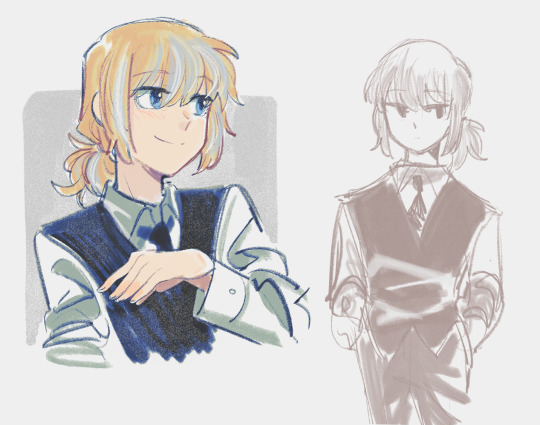
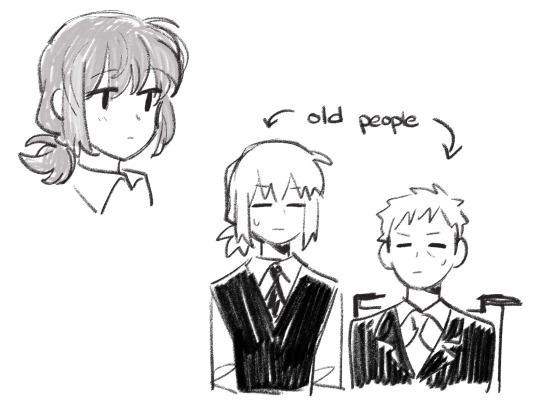
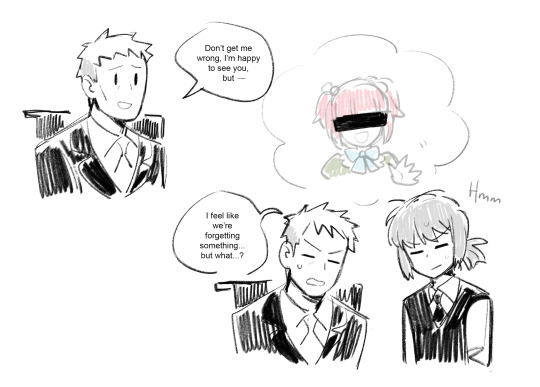
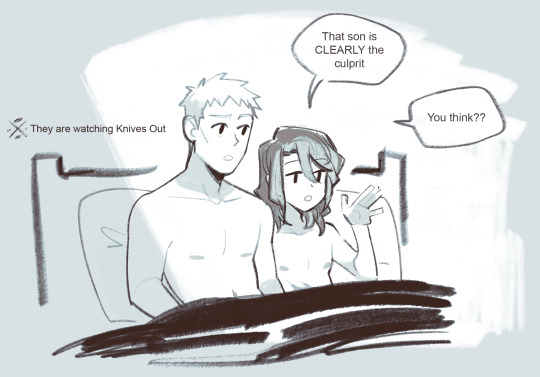
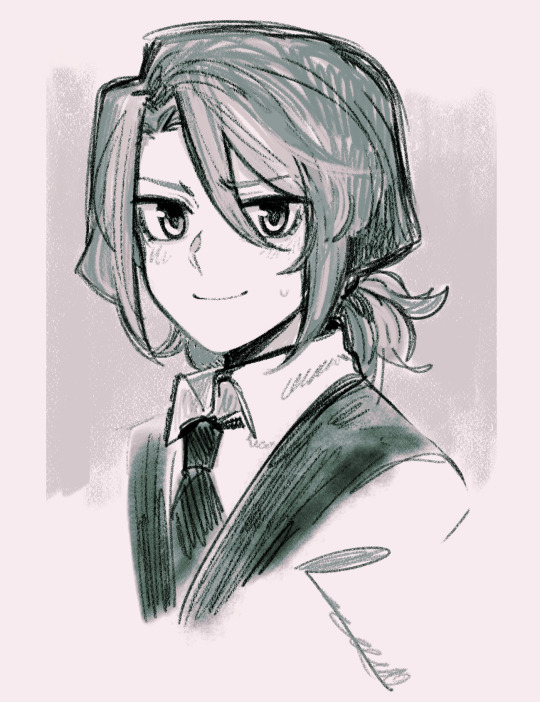
Tohya and Yasu nonsense
358 notes
·
View notes